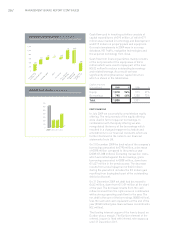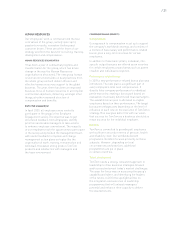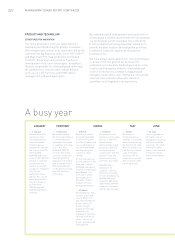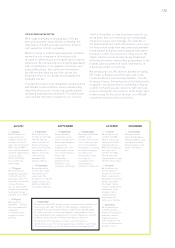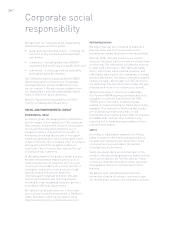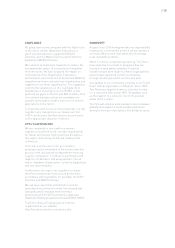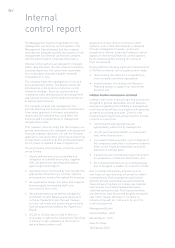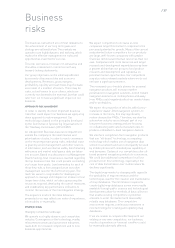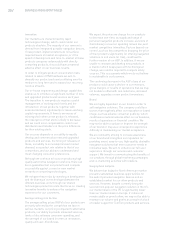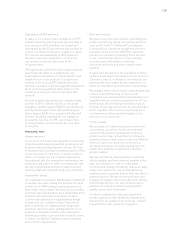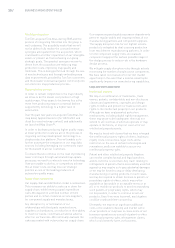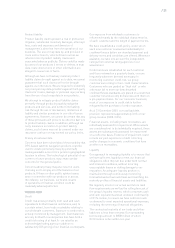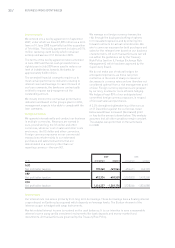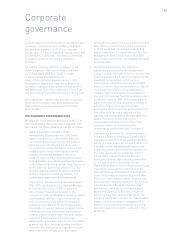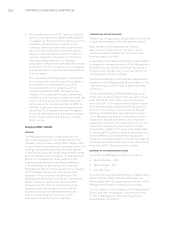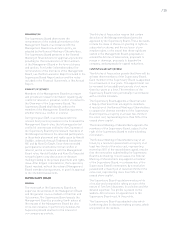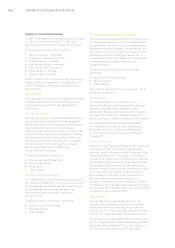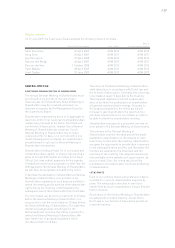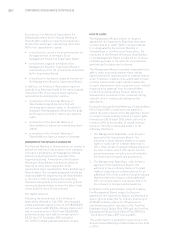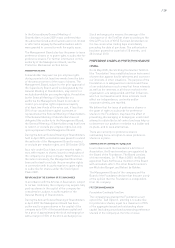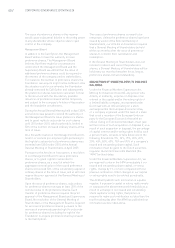TomTom 2009 Annual Report Download - page 32
Download and view the complete annual report
Please find page 32 of the 2009 TomTom annual report below. You can navigate through the pages in the report by either clicking on the pages listed below, or by using the keyword search tool below to find specific information within the annual report.30 / BUSINESS RISKS (CONTINUED)
Tele Atlas integration
TomTom acquired Tele Atlas during 2008 and the
process of integrating Tele Atlas into the group is
well underway. The possibility exists that we will
not be able to fully realise the cost and revenue
synergies anticipated from the acquisition, which
could lead to a further impairment of our intangible
assets or prevent us from achieving our group
strategic goals. The greatest synergies we aim to
derive from the acquisition are reducing map
production costs, improving map quality and
freshness. This is being performed through the use
of new technologies and through embedding map
data improvements provided by TomTom customers
and the broader external navigation community into
our electronic map production process.
Map production process
In order to remain competitive in the map industry
we strive to be the lowest cost producer of high
quality maps. A key aspect of achieving this is the
move from producing maps in a manual fashion
supported by technology to a higher level of
automation.
Over the past few years we acquired Tele Atlas (for
map data), Applied Generics (for HD Traffic) and
ilocal (for enriched map content), and additionally
we launched Map Share™.
In order to facilitate producing higher quality maps
at lower production costs we are in the process of
migrating our map development technology to a
single production platform. This will enable us to
further automate the integration of our map data
sources including leveraging our community input
for the benefit of all our customers.
To ensure that we continue on the road of producing
lower cost maps through automated map update
processes, we need to continue to invest in technology.
If we are unable to do this, or competitors achieve
this at lower costs, we may lose our strategic
position as one of the leading producers of
automotive quality maps.
Supply chain outsourcing
Our supply chain and distribution model is outsourced.
This increases our ability to scale up or down the
supply chain, while limiting capital expenditure
risks. We depend on a limited number of third
parties and in certain instances on sole suppliers,
for component supply and manufacturing.
Any disruption to, or termination of our
relationships with third party manufacturers,
suppliers or distributors, or reduction in their ability
to meet our needs, could have a material adverse
effect on our business. We continually evaluate the
risks associated with outsourcing our supply chain.
Our engineering and quality assurance departments
perform regular audits and ongoing reviews of our
manufacturing partners and component suppliers.
The supply disruption risk for our highest volume
products is mitigated by dual-sourcing production
from two different manufacturing partners. In order
to limit component supply risks, we evaluate
component supply at the earliest possible stage of
the design process to reduce risk in the hardware
design process.
We mitigate supply disruption risks through actively
minimising the number of single source components.
We have taken out insurance for our lost market
opportunity in the event that a natural catastrophe
significantly impairs our manufacturing capabilities.
LEGAL AND COMPLIANCE RISKS
Intellectual property
We rely on a combination of trademarks, trade
names, patents, confidentiality and non-disclosure
clauses and agreements, copyrights and design
rights to define and protect our trade secrets and
rights to the intellectual property in our products.
Although we have implemented protection
mechanisms, including digital rights management,
these may prove to be inadequate: they may not
extend to all countries in which we operate or may
operate in the future, or may not cover all of our
intellectual property assets.
We may be faced with claims that we have infringed
the intellectual property rights of others, leading to
royalty costs, license fees, legal costs, and a
restriction on the use of certain technologies and
innovations, and/or an inability to secure our
intellectual property rights.
Patent and other intellectual property litigation
can involve complex factual and legal questions
and its outcome is uncertain. Any claim relating to
infringement of patents that is successfully asserted
against us may require us to pay substantial damages
or we may be forced to stop or delay developing,
manufacturing or selling products. In such cases,
we may be required to obtain licenses to patents or
proprietary rights of others, which may not be
available on favourable or acceptable terms or at
all, or to modify our products to avoid incorporating
such patents or proprietary rights, which may
not be possible, in order to continue to sell our
products. Even if we were to prevail, any litigation
could be costly and time-consuming.
Ultimately, we may incur significant additional
costs or be unable to develop and market some
of our products or may have to cease some of our
business operations as a result of patent or other
intellectual property rights infringement claims,
which could severely harm our business.


